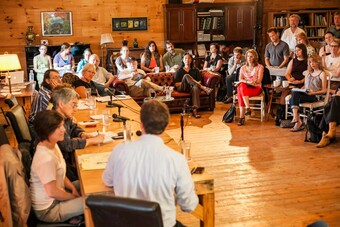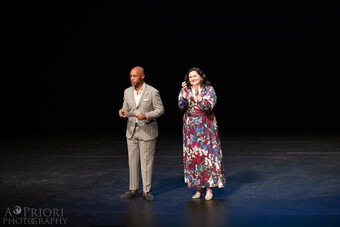Participation
Why Play Along?
Participation is the core of social media. Individuals share, like, pin, drop hashtags and handles, and otherwise create virtual word-of-mouth. As theatres like New Paradise Laboratories, Nerve Tank*, and Praxis Theatre explore artistic possibilities of social media within performance, audiences are encouraged to download, comment, or tweet. It’s the participation of a vast audience that makes crowdfunding, crowdsourcing, and social media culturally relevant, immediate, and viable. We need to think about more than how to tap social media. Our ability to design participation, to create connection and a feeling of membership, and to appeal to our audience’s desire to demonstrate their generosity, autonomy, and competence will be more crucial to our success in the years ahead than any one social media phenomenon.
Participation as Resource
We need to reconsider what resources our audiences, through their participation, might be willing to offer. We appeal to their financial resources. At times we appeal to their time and limited skills, such as volunteer ushering and help with mailings. In some instances, we draw from their more highly developed skills and creativity. An education program’s teacher advisory committee will be asked to draw from their expertise, experience, and interest to help the theatre brainstorm, troubleshoot, and create a greater connection between the theatre and the schools. The Internet makes it possible to capitalize on audiences’ skills, abilities, interests, creativity, and effort in online projects that create greater resources for everyone. Clay Shirky refers to this potential as “cognitive surplus” and gives us examples such as LOLCATS, Josh Groban fans’ charity work, and crowdsourcing projects like Wikipedia, Linux, online patient support groups, and sites that map locations of survivors in Haiti or chart incidents of rape in India. In Cognitive Surplus: How Technology Makes Consumers into Collaborators, Shirky argues that “this increase in our ability to create things together, to pool our free time and particular talents into something useful, is one of the great new opportunities of the age, one that changes the behaviors of people who take advantage of it.”
The Appeal
With a greater capacity to create work online, potential projects must be considered in the light of why audiences would want to spend their time on them. Appealing to an interest is one thing, but with competing interests and needs, interest does not always translate into action. Payment can be motivating. That alone, however, isn’t enough; in fact, people who are already interested in doing something may become less likely to participate when they are paid for it, Shirky argues, citing psychologist Edward Deci. What motivates people, Shirky suggests, is a combination of intrinsic and social motivations:
- “the desire to be autonomous (to determine what we do and how we do it)
- the desire to be competent (to be good at what we do)”
- the desire for connectedness and membership
- the desire to share and be generous.
Take, for example, the New Play Exchange. When Gwydion Subilebhan first posted on HowlRound what he called the New Play Oracle, people were fascinated by his proposal for a centralized online play database in which playwrights would post their plays, and theatres, literary managers, and dramaturgs would read and recommend them. The motivation for playwrights was clear. But what would motivate enough theatres, literary managers, and dramaturgs to participate?
Looking at the announcement of what will now be known as the New Play Exchange, several of these motivating factors are at work:
- The desire for membership and connectedness. The New Play Exchange will be run by the National New Play Network, along with their partners Chicago Dramatists, New Dramatists, the Literary Managers and Dramaturgs of the Americas, the Playwrights’ Center, and the Playwrights’ Foundation. Will colleagues across these organizations find added value being connected to each other through the New Play Exchange? Will participation lead to a sense of membership?
- The desire to share and be generous. It feels good to be generous and to share a good play, and, despite what anyone says, literary managers and dramaturgs love doing just that. Focusing on writing recommendations appeals to generosity, and asking a “trusted reader” for a private second opinion allows that reader a choice to respond to the script without being accused of acting ungenerously if that opinion is negative.
- The desire for competence. Julie Felise Dubiner’s call for a national new database for plays was part of a manifesto against a literary office and literary role set up in such a way that it alienates people from feeling and demonstrating competence. If the New Play Exchange helps theatres, literary managers, and dramaturgs do what they do better, they’ll use it. And in designating someone as a “trusted reader,” the New Play Exchange appeals to social recognition of competence.
While the New Play Exchange is geared towards participation of professionals, projects can successfully draw upon audiences that have a range of expertise but share a common interest.
Tod Machover’s vision for creating A Toronto Symphony was to include Toronto residents in the creative process. Machover designed for autonomy by presenting contributors real choices. He invited people to upload audio files recorded around Toronto. He invited orchestras to “mess” with his chords. He asked bands to record endings. With an app developed at MIT, people could alter the melody he was creating for a certain section. Contributions from students and the general public demonstrated competence as well as creativity. Because they were helping in creating a piece for their city, participants, over 10,000 of them, could feel generous as well. Rather than reeling from participation overload, Machover has started his participatory process over again with Edinburgh: Festival City, which will be part of the Edinburgh International Festival later this year.
“this increase in our ability to create things together, to pool our free time and particular talents into something useful, is one of the great new opportunities of the age, one that changes the behaviors of people who take advantage of it.”

Artistic Control?
A Toronto Symphony is not a completely open-source project like Linux or Wikipedia; Machover retains creative control over the submissions and authorship of the piece. Although an online open-source art piece in which no one person has creative control and everything is decided by the group may have amazing results, that isn’t a requirement for participatory online projects. The real prerequisite is having a clear concept of why participation is being solicited and how it will be incorporated into the piece. Machover had this. He could even show people how he conceived of participation fitting into the structure of the piece.
Designing Participation
A Toronto Symphony also demonstrates the importance of assessing the feasibility of participation and considering various types of participation. Machover made sure that the technology needed to participate in A Toronto Symphony would be accessible. Recording and submitting audio files is easy on a smartphone (for me, with my digital recorder, it takes a few more steps, but it’s possible). Composing music, however, is much more complicated. So Machover’s MIT Media Lab PhD students created web apps that could be manipulated with a mouse and did not require understanding music theory or the ability to play an instrument. In one web app, “City Soaring,” participants could “paint the quality of a melody. Grab one of the four ‘brush’ icons in the top right-hand corner of the app window—weight, complexity, texture and intensity—and paint over the line with it.” They were told, “You’ll immediately see the change in color and texture and will hear the changes when you play back the melody from the scroll bar at the bottom of the screen.”
Machover has also appealed for and facilitated more than one type of participation. He asked people to collect and send in sounds. He asked people to record their own music. He asked people to revise his work to create new melodies or alter chords. It’s a good reminder that whether because of personalities, the platform, or the subject, online participation clearly encourages participation to take different forms. Yes, some people create content. Some people also like to revise or play with an original and create something else (Toronto symphony web apps, memes, fan fiction). People will collect or group things (Pinterest), share (Facebook, Twitter), or chart or map (see Ushahidi).
One type of online participation has been particularly challenging for theatres; some people really enjoy reviewing, rating, and commenting. Praxis Theatre in Toronto believes social media offers two-way engagement, and that theares can’t escape that reality. Artistic Director Michael Wheeler believes they’ve been successful when feedback was designed to be part of the event, even in new play development. Yes, they’ve had to deal with trolls and hurtful comments, and even highlighted an entry that asked, “how, in this world of aesthetic and political difference, can you tell, in anonymous or unknown comments, who to listen to—who shares any values?” But Wheeler feels the immediacy of live feedback is worth the effort. He’ll still ask for face-to-face feedback from artists he trusts, and Praxis does not ask for feedback on every new piece. They’ve learned to create parameters for feedback and insist that social media tools get “into the hands of artists and dramaturgs so they are actually embedded in the work and ideas that surround it.”
Additionally, with greater access and more potential outlets to publish information, ideas, and opinions, it is not surprising that some theatregoers, wanting more autonomy than a questionnaire or talkback allows them and needing more space to share their competence than in a comments section of a newspaper, have gone to blogs. Blaming amateur bloggers who choose to use their cognitive surplus to write about theatre for the changes taking place in publishing and criticism, for the quality of art and artistic programming, or for the decline in theatre attendance smacks of scapegoating and, more importantly, seems like a missed opportunity to recognize and enlist a potential ally. Most of the bloggers I have read act out of a sense of generosity in that they feel their writing is reaching readers or covering artists in a way that professional outlets do not.
Looking Ahead
A myriad of possibilities exist—what might they be? What could a committee of volunteer online ambassadors accomplish? Would a wiki map of the United States that locates where plays were set appeal to tourists, teachers, and the generally curious? Could a theatre put on a story-fundraiser and invite audiences to share why they come to the theatre, or to talk about a particularly meaningful production? Give me a specific time, a range of choices—to write it down, to record it with a friend in StoryCorps style, or send in an image, perhaps a photo with a caption—and a clear purpose for this advocacy, and I would respond. Would a story-fundraiser feel too scripted and provoke ironic or troll-like responses? That is a possibility. How much do any of these ideas create connection and membership? Would they appeal to our audience’s to desire to demonstrate their generosity, autonomy, and competence? Asking these questions and engaging in discussion in person and online will help us to not just use the Internet and social media, but to get real value out of them to the benefit of everyone involved.
* See Jonathan Mandell’s “All the Media is a Stage,” January 2013 American Theatre.










Comments
The article is just the start of the conversation—we want to know what you think about this subject, too! HowlRound is a space for knowledge-sharing, and we welcome spirited, thoughtful, and on-topic dialogue. Find our full comments policy here
Another good example would be all the Citizen Science projects that have developed over the past five years. Science enthusiasts have been asked to help process massive amounts of data in the hopes of revealing patterns about systems still too complex for computers to analyze on their own. Old Weather is probably the most well known, http://www.oldweather.org. It is part of a larger group of projects like this located at https://www.zooniverse.org
Amy Jensen, this reply is not as comprehensive as I would like it to be, but I want to point to a recent article by a colleague of mine who teaches at the Akademie der Kuenste in Berlin. Barbara Gronau recently published an article entitled DAS VERSPRECHEN DES REALEN - The Promise of the Real - in response to Dimiter Gotscheffs production of "Shakespeare. Spiele fuer Moerder, Opfer und Sonstige". In translation "Shakespeare. Games for Murderers, Victims, and Others. In the article Gronau creates a beautiful arch between theatre's age old obsession to be real, and the efforts since its origin to effect, involve, implicate and make audiences participatory. She ends the article by comparing two land mark productions: Heiner Mueller's Arturo Ui and Richard Schechner's Commune in 1970.
Gronau quotes Schechner and says: "Participation – Richard Schechner once said –
always marks the moment, when "the performance breaks down and becomes a
social event". The Real is then not the coincidence of the aesthetic and the social (or the participatory), or the coincidence of art and life (Stanislavski) but the continuation of the one with the ending of the other. The real in theatre is an island in the field of the aesthetic.
Not theatre itself stops and transforms into a social event, but the production stops and the performance continues. With the end of the rehearsed and set production the end of art is not reached, but rather art begins to turn political at this instant and moment: as an equal process of negotiation of everyone present at the performance, asking the question: Who plays what under what conditions?
That is Schechner in 1970. An American, many decades before the advent of the "interference" of social media in performance. Particpation in theatre is not a question of the medium used for it, or how to virtually engage an audience across times, spaces, and ideological or intellectual fields historically, aesthetically, or anthropologically. It is the art of interruption. When I interrupt an event which by its interruption does not meet the audience's preconceived notion what is supposed to happen, or which button they are supposed to press in order to respond or fake respond; but when instead zI truly derail the event, and create an immediate, transparent, and total interruption, I implicate everyone present - performers and audience alike - and ask the fundamental question: do we have the courage and the patience to look at the political structure in this very gathering? What are the ideological and political goals and traditions inscribed in this gathering? Are they open, ouvert, or are they hidden, assumed? If so, why?
The way participation is currently framed and discussed in the United States theatre and art world is unfortunately tied to the prevalent fascist models of control and greatest consumer output and producer profit possible in other related American economies and industries.
It's been fascinating, complicated, and super rewarding to tackle rethinking use of social media during performance, beyond the "tweet seats" phenom/debate, as part of the narrative or experiential arc of a show. dog & pony dc's first time out threading Twitter throughout our piece A KILLING GAME was mildly successfully overall--we made some rookie mistakes by our standards scaffolding participation with the "new tool"--but the one thing there was no question about: social media built connections and created community during the show. Among its users--the audience members and characters in the show.